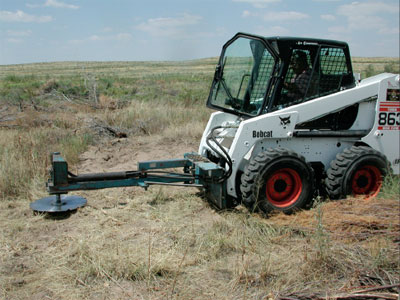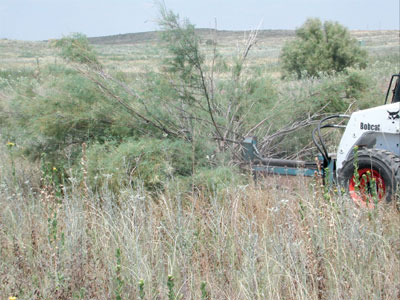Cimarron National Grassland Time and Motion Study
The time and motion study included two phases: the first considered mechanical treatments to remove tamarisk, and the second considered chemical treatments to kill the sprouts.
Phase 1—Mechanical Treatments
The overall goal of the study was to find the best way to remove tamarisk, while minimizing the use of chemical herbicides needed to kill sprouts. Phase 1 compared using the JAWZ attachment to pull out the tamarisk stems and root ball to using a brush saw mounted on a skid steer to cut the tamarisk stems at the ground line.
The original plan was to attach the JAWZ attachment to a PC50MR compact excavator and pull the plants. The compact excavator (with rubber tracks) could have piled the trees for burning and should have been able to maneuver easily in the sandy soils. Things did not work out as planned. Because the JAWZ attachment had to be mounted where it was working on the weak side of the excavator's hydraulic cylinder, the PC50MR compact excavator did not exert enough force to do the job.
A Bobcat T300 compact tracked loader (figure 8) was rented to replace the PC50MR compact excavator. The T300 has rubber tracks for improved maneuverability and flotation. The T300 compact tracked loader has 81 horsepower, a boom breakout force of 6,700 pounds, and a rated lifting capacity of 3,000 pounds.

Figure 8—T300 Bobcat Compact Track Loader
(Photo courtesy of Bobcat Co.). No photos with the
JAWZ mounted on the T300 were available.
One eradication method now used on the Cimarron National Grassland involves cutting tamarisk. Figures 9a through 9d show how the Cimarron National Grassland cuts tamarisk with a rigid Bobcat brush saw mounted flush with the ground on a skid steer.

Figure 9a—A Bobcat brush saw mounted on a skid
steer loader.

Figure 9b—The Bobcat brush saw being used to cut
tamarisk.

Figure 9c—The skid steer loader equipped with
a Bobcat brush saw approaches a tamarisk plant.

Figure 9d—A tamarisk stump left after the plant was cut
by a brush saw mounted on a skid steer loader.
The study site (divided into two study plots) was east of the Cimarron River crossing on Morton County Road 16 (figure 10). Both study plots ran north and south across the river. Cimarron National Grassland employees flagged the plots with surveyor's tape. The tamarisk infestation was heavier on the north side of the river than on the south. The two 25-acre plots are adjacent to each other and have sandy soil.

Figure 10—The study site at the Cimarron National Grassland was divided into a cutting plot and
an extraction (or pulling) plot.
The JAWZ attachment mounted on the rented Bobcat T300 compact tracked loader was used in one of the study plots. The rigid brush saw mounted on the Bobcat S160 skid steer loader was used in the other. The operators recorded time spent maintaining equipment, (fueling, greasing fittings, checking bolts, and so forth) and the time spent pulling trees or cutting them each day. Some very large clumps of tamarisk required more than one operation to remove the whole plant. The operator of the rubber-tired Bobcat S160 had to be careful when maneuvering to prevent the skid steer from getting stuck. The operator of the tracked T300 compact tracked loader did not have to worry about getting stuck.
Photopoints were set for monitoring. Cimarron National Grassland employees took before-and-after pictures (figures 11a through 13) of the overall study site.

Figure 11a—The cutting plot before the tamarisk
trees were removed (July 17, 2007).

Figure 11b—The same plot after the tamarisk
trees were cut (December 20, 2007).

Figure 12a—The pulling plot before the tamarisk
trees were removed (August 16, 2007).

Figure 12b—The same plot after tamarisk
trees were pulled (December 20, 2007).

Figure 13—Piles of plant material (December 17, 2007).
Even though the study plots were the same size (25 acres), the pulling plot had slightly more tamarisk, which accounted for the extra time that was spent pulling tamarisk rather than cutting it during the study. The fuel loading left after the tamarisk was pulled would have damaged the standing cottonwood trees if the dead trees were left in place and burned by prescribed fire. All heavier concentrations of cut or pulled tamarisks were piled by a bulldozer for burning the winter after the mechanical treatment. Table 2 compares the cost of pulling tamarisk to the cost of cutting it.
| Cutting | Pulling | |
|---|---|---|
| Cutting or pulling time | 76.25 h | 91 h |
| Horsepower | Bobcat S160—56 hp | Bobcat T300—81 hp |
| Maintenance | 15.25 h | 18 h |
| Fuel used | 92 gal | 148 gal |
| Labor cost | $1,410.93 | $1,680.78 |
Although two different operators (earning different pay) conducted different parts of the study, the labor rate was figured at $15.42 per hour rather than the operators' actual pay.
Maintenance and Repairs
Forest Service employees completed all repairs on the brush saw and JAWZ attachment using standard parts available locally. The Bobcat dealership in Garden City, KS, made all repairs to the Bobcats.
Brush Saw
Summary of maintenance included:
- Hydraulic hoses were replaced twice due to
normal wear and tear (including some use
before the test).
- The Bobcat S160 got stuck several times in
the sandy soil. The time spent getting it out
was considered maintenance.
JAWZ Attachment
Summary of maintenance included:
- The bolts that hold the JAWZ to the top
plate were sheared off.
- The cover on the top plate was pushed in,
breaking the coupler on the hydraulic hose.
- The cover on both hydraulic cylinders was
pushed in.
- The step on the top/front corner of the
mounting plate was pushed in.
- The O-ring on the top of the hydraulic block behind the cover on the top plate was replaced twice.
Bobcat Repairs
Summary of maintenance included:
- The T300 compact tracked loader was an
older and well-used machine that required
more general maintenance by Forest Service
personnel.
- The windshield on the S160 skid steer loader
broke while it was in transit and the windshield
on the T300 compact tracked loader
broke while it was being used in field.
- The T300 compact tracked loader had
radiator and air conditioner leaks.
Equipment Operators' Comments
Equipment operators' comments included:
- The operator who was pulling the tamarisk felt
that the JAWZ was more efficient than the
cutting saw.
- Both operators said the T300 compact tracked
skid steer loader had better mobility than the
S160 rubber-tired skid steer loader.
- The JAWZ attachment was not closing completely
during the final stages of the study. The
gap between the blades allowed plants to slip.
- The JAWZ attachment would work better and
faster if it was mounted lower on the mounting
plate.
- The plants could be pulled more easily during
the spring when the soils are damp.
- Although it took more time to pull tamarisk
than to cut it off, there may be less regrowth,
and less chemical may be needed to control
regrowth.
- The pulling and cutting plots were evaluated for regrowth the following spring, before they were chemically treated.
Phase 2—Chemical Treatments
The study site (figure 14) and the rest of the Cimarron National Grassland experienced extreme drought from July 2007 to August 2008. During August 2008 about 4 to 6 inches of rain fell, causing much of the understory vegetation (grasses and forbs) to grow rapidly. The more drought-tolerant species responded more vigorously than others.

Figure 14—A portion of the tamarisk study site (September 4, 2008).
The tamarisk infestation was heavier on the north side of the river than on the south side. The infestation was heavier on the southwest side of the river than on the southeast side.
Tamarisk resprouted abundantly from stumps when it was cut with a brush saw. The height of the tamarisk sprouts ranged from 3 feet to about 6 feet (figure 15). There were few sprouts in the pulling plot where tamarisk was extracted with the JAWZ attachment. The height of the tamarisk sprouts there ranged from 1 foot to about 5 feet (figure 16).

Figure 15—An overview of the study site where tamarisk
trees were cut (September 4, 2008). The bare ground is
where piled tamarisk was burned.

Figure 16—An overview of the study site where tamarisk
trees were pulled (September 4, 2008).
Tamarisk was pulled during September 2007 when the soil was dry. Some tamarisk clumps had to be worked back and forth to pull them free. Plants that broke off at the top of the main root resprouted from root material left in the ground. These sprouts did not grow as tall as sprouts that grew from stumps because the stumps and their intact roots had more energy for resprouting.
Grasses at the study site include Paspalum dilatatum (dallisgrass), Distichlis spicata (saltgrass), Eragrostis trichodes (sand lovegrass), Hordeum jubatum (foxtail barley), and Sporobolus cryptandrus (sand dropseed). Forbs include Croton texensis (Texas croton), Salsola kali (Russian thistle), Ambrosia artemisiifolia (annual ragweed), Amaranthus retroflexus (redroot pigweed), and Chenopodium album lambsquarters), with an occasional Helianthus annuus (common sunflower).
The tamarisk sprouts were treated with herbicide between August and October 16, 2008. The tamarisk south of the river was treated with Pathfinder II herbicide. Tamarisk north of the river was treated with the herbicide Triclopyr 4EC (generic equivalent Garlon 4) mixed with diesel.
South of the Cimarron River, 47.5 gallons of Pathfinder II were applied to tamarisk sprouts on about 26 acres. In the area where the tamarisk was cut, 85 percent more sprouts were treated than in the area where tamarisk was pulled. Thirty-three gallons of Pathfinder II were used in the area where tamarisk was cut compared to 15 gallons of Pathfinder II used in the area where tamarisk was pulled. Some of the sprouts were treated twice because they appeared to have been missed on the initial treatment or the chemical didn't appear to have an immediate effect on the plants. More Pathfinder II was used than had been expected.
North of the Cimarron River, about 7 gallons of Triclopyr 4EC was applied to about 24 acres. The area where tamarisk was cut had about 85 percent more sprouts to treat than the area where tamarisk was pulled. Four gallons of Triclopyr 4EC (with 16 gallons of diesel) were applied in the area where tamarisk was cut. Three gallons of Triclopyr 4EC with 12 gallons of diesel) were applied in the area where tamarisk was pulled.

